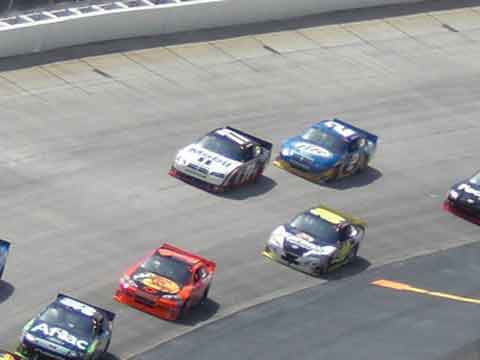One of the widespread grievances regarding NASCAR telecasts is that certain drivers receive too much attention in comparison to other drivers. It is true; Dale Earnhardt Jr, Jeff Gordon, and Tony Stewart are the primary focus in many NASCAR broadcasts, but they are the three most recognizable faces in the sport. Jimmie Johnson seldom runs anywhere but the top five or top ten, so he will receive a lot of attention from the broadcasters as well. It is the fans of the remaining 38 drivers that feel inclined to gripe about NASCAR telecasts.
There are Dave Blaney and Sterling Marlin fans out there. The reality is that there are not enough of them out there to warrant the coverage parallel to Earnhardt Jr or Gordon. Unless they happen to run near the front, you may never hear their name mentioned for the entire race.
So what is the solution for these fans? Several years ago, you would simply have to deal with your favorite driver’s lack of coverage, but now fans have discovered Raceview on NASCAR.com. It is a 3-dimensional way to follow any driver of your choosing. The program allows three different views of the car, and it is somewhat accurate to the actual racing on the track.

Of course, Raceview has its flaws. Firstly, it looks similar to a NASCAR video game from the 1990’s. At times, the cars behavior is unrealistic, and sometimes the appearance of the cars is somewhat distorted. A couple of weeks ago, I was following various drivers, and I noticed that Ken Schrader’s car was driving backwards. It was comical yet irksome all at the same time.
Additionally, it can take a few minutes for the program to get up and running.
Raceview is far from seamless; however, if you want to follow a certain driver other than Earnhardt Jr, Jeff Gordon, Tony Stewart, or Jimmie Johnson, you should give it a shot. The scanner has also become an advantageous tool for the hardcore fans, as it gives them the option to choose a driver and eavesdrop on their in-car audio.
Take a brief look at the evolution of NASCAR telecasts
Back in the 1960’s and 1970’s, the best view of a NASCAR, or Grand National race was actually attending the race. Of course, it was not feasible for everyone to attend one of these events. Finally, in 1979, CBS broadcasted the Daytona 500. It was the first nationally televised NASCAR race, and boy was it a memorable one.
Throughout the 1980’s, more and more NASCAR races were being broadcasted on ESPN and other various television channels. Because there was no leaderboard ticker displayed across the top of the screen, the commentators were more informative as far as the positions of different drivers.
In the mid-1990’s, most of NASCAR telecasts began to display a leaderboard ticker. When FOX and NBC raided that NASCAR broadcast booth in 2001, they implemented several little gimmicks such as the FOXTracks.
Presently, many fans with the luxury of owning a laptop have these additional tools to add to their NASCAR viewing experience.
If only my grandfather, an avid David Pearson fan, had these luxuries forty years ago. It is safe to say that the modern NASCAR fan is spoiled, which is why they may nitpick at certain discrepancies with the current broadcasts.